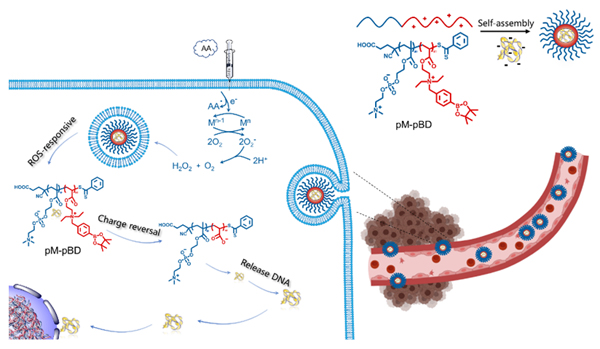摘要/Abstract

引入快速、主动释放基因的机制是提升非病毒基因递送效率的关键. 本研究以2-甲基丙烯酰氧乙基磷酰胆碱(MPC)与(2-丙烯酰基)乙基(硼酸苄基)二乙基溴化铵(BD)为单体, 基于可逆加成-断裂链转移聚合(RAFT)反应制备具有活性氧响应性质的聚阳离子嵌段共聚物pM-pBD. 通过静电作用, 阳离子共聚物pM-pBD能够与带负电荷的DNA以分子自组装的方式形成纳米复合物. 其中, 阳离子pBD片段具有活性氧触发电荷反转的特性, 因此, 有助于获得活性氧触发的静电组装复合体结构解离, 从而实现可控基因释放的功能. 理化表征结果表明, pM-pBD与质粒DNA静电复合后能够形成粒径约为99.1 nm, ζ电位约为+13.8 mV, 显微形貌近似球形的纳米复合物. 在加入促过氧化氢产生的抗坏血酸后, 上述pM-pBD基因递送系统的转染效率得到了显著的提升. 因此, 本研究创制的pM-pBD为基因递送系统的可控释放提供了新的解决方案.
关键词: 聚阳离子, 电荷反转, 基因递送, 活性氧响应, 抗坏血酸
The development of rapid and active gene release function is the key to improve the efficiency of non-viral gene delivery system. Herein, a novel reactive oxygen-responsive cationic block copolymer non-viral gene delivery vector (termed as pM-pBD) consisting of biocompatible poly(2-methacryloyloxyethyl phosphorylcholine) (pMPC) segment and charge reversible poly[(2-acryloyl)-ethyl-(boronic acid benzyl)-diethylammonium bromide] segment (pBD) was synthesized via reversible addition-fragmentation chain transfer polymerization (RAFT). Dynamic light scattering (DLS) assay and ζ potential measurements, transmission electron microscope (TEM) and gel electrophoresis were performed to characterize pM-pBD/(plasmid DNA, pDNA) complexes. Gel electrophoresis retardation assay displayed that pM-pBD can firmly bind pDNA through electrostatic interaction even in the presence of high concentration of heparin, but capable of releasing pDNA in response to reactive oxygen (such as H2O2). The pM-pBD/pDNA complexes show low cytotoxicity against HeLa cells, even at high weight ratio of pM-pBD and pDNA (N/P) (up to 16) demonstrated by MTT (methylthiazolyldiphenyl- tetrazolium bromide) assay. The pM-pBD/pDNA complexes demonstrated appreciable colloidal stability in the presence of 10% fetal bovine serum. The pM-pBD/pDNA complexes at N/P ratio of 3 displayed spherical morphologies with average diameter of approximate 99.1 nm and ζpotential of approximate +13.8 mV. However, once upon incubation in presence of 1 mmol/L H2O2, the diameter of pM-pBD/pDNA complexes at N/P ratio of 3 was enlarged to 330 nm and ζ potential was reversed to –3.91 mV due to charge reversal of BD responsive to reactive oxygen. Flow cytometry revealed uptake efficiency (88.9%) and the highest transfection efficiency (31.2%) for pM-pBD at N/P ratio of 3 and 16, respectively. The transfection efficiency of pM-pBD/pDNA against HeLa cells was observed to be significantly augmented (1.5-fold) after the addition of ascorbic acid, which could stimulate the production of hydrogen peroxide. Therefore, pM-pBD represented intriguing utilities in fabrication of non-viral gene delivery systems, which enable spatiotemporal control of gene release and thereby facilitated the subsequent transcription machinery.
Key words: polycation, charge reversal, gene delivery, ROS-responsive, ascorbic acid
PDF全文下载地址:
点我下载PDF
